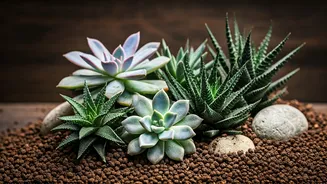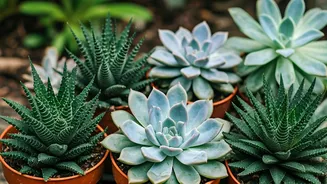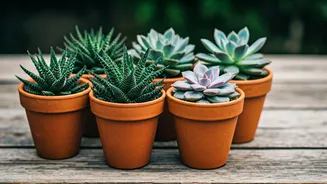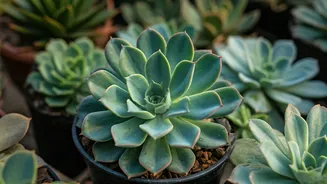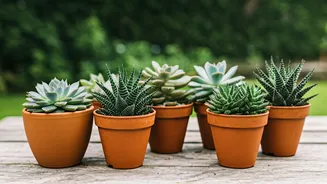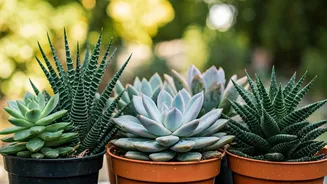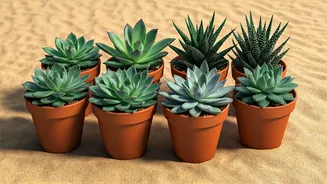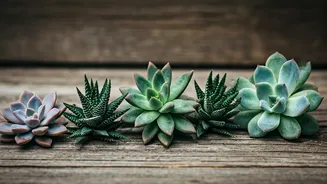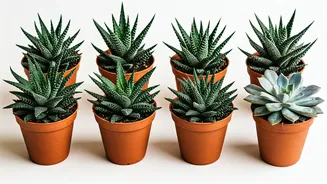Succulents: A Brief Intro
Succulents, prized for their ability to conserve water within their leaves, stems, and roots, have evolved to endure harsh environments. This characteristic
makes them exceptionally low-maintenance and ideal for those with busy schedules or limited gardening experience. The appeal of succulents extends beyond their practicality, encompassing a wide array of shapes, sizes, and colors that offer endless possibilities for aesthetic arrangements. Succulents originate from diverse geographical regions, including arid and semi-arid locales around the world. These plants have adapted to flourish in these challenging conditions, accumulating water in specialized tissues. This unique ability enables them to withstand prolonged droughts, making them perfectly suited for environments with erratic rainfall. Their adaptability has enabled them to thrive in various settings, ranging from indoor containers to outdoor rock gardens.
Sempervivum (Houseleeks)
Sempervivum, commonly known as houseleeks, are renowned for their incredible resilience and longevity. Native to the mountainous regions of Europe, Asia, and North Africa, they have adapted to thrive in harsh climates. These succulents are characterized by their rosette formations, displaying an array of colors and textures that enhance their visual appeal. Their remarkable ability to endure adverse conditions makes them a favorite among both novice and experienced gardeners. Sempervivum is incredibly adaptable, tolerating various soil types and requiring minimal watering, which contributes to their long lifespan. These plants typically spread by producing offsets, or “chicks,” around the parent plant, facilitating effortless propagation. Houseleeks are well-suited for rock gardens, containers, or even living walls, adding an element of natural beauty to any landscape. Given their hardy nature and ease of care, Sempervivum can last for numerous decades with proper attention.
Agave: Desert Giants
Agave plants are recognized by their dramatic, architectural form and capacity for enduring drought. Originating from the Americas, these succulents have adapted to thrive in arid and semi-arid conditions, exhibiting remarkable hardiness. Agave species encompass a diverse range of sizes and shapes, from petite varieties suitable for containers to imposing species that can reach several meters in height. Their distinct rosette formations and sharp-edged leaves add a unique visual element to any garden. The lifecycle of an agave is often quite lengthy, with many species living for several decades before flowering. After blooming, the plant usually produces a tall flower stalk, and then dies, although they often produce offsets, continuing the cycle. Agaves are highly versatile, suitable for xeriscaping, rock gardens, and container planting. Their low-maintenance nature and ability to tolerate neglect make them a fantastic choice for those seeking resilient and aesthetically pleasing plants, potentially lasting for more than 50 years.
Aloe: Healing Powerhouse
Aloe, especially Aloe vera, is celebrated for its medicinal properties and adaptability, and it is a succulent that has found its place in gardens worldwide. Originating from the Arabian Peninsula, this plant has spread across the globe and adapted to diverse climates. The fleshy leaves of aloe, filled with a gel rich in healing compounds, are used for treating burns, cuts, and various skin ailments. Aloe's resilience comes from its ability to retain water within its leaves. Aloe plants are relatively low-maintenance, requiring infrequent watering and thriving in well-draining soil. Their adaptability makes them ideal for indoor and outdoor settings. With proper care, certain aloe varieties can live for several decades, contributing both beauty and wellness to any environment. Aloe vera, in particular, is frequently cultivated for its medicinal properties and its ease of propagation, contributing to its enduring appeal.
Sedum: Groundcover Heroes
Sedum, a diverse genus of succulents, presents a wide array of options for ground cover and container planting. Sedums are particularly adaptable, with varieties that are well-suited for diverse climates and conditions. They are known for their varying forms, ranging from low-growing mats to upright, shrubby plants, providing versatility in garden design. Their water-storing capabilities enable them to thrive with minimal attention, making them perfect for xeriscaping and low-maintenance gardens. Many sedum species offer attractive foliage and beautiful flowers, enhancing the aesthetic appeal of any landscape. These succulents are relatively easy to propagate, and they can last for many years with appropriate care. Their ability to tolerate drought, along with their aesthetic appeal, positions them as a great choice for both novice and seasoned gardeners. Sedums’ varied forms offer many choices, from ground-hugging types to taller varieties.
Crassula (Jade Plant)
Crassula, commonly known as the jade plant, is a well-loved succulent recognized for its tree-like appearance and long lifespan. Originating from South Africa, this plant has become a popular choice for indoor cultivation worldwide. The jade plant is easily identified by its thick, oval-shaped leaves and sturdy stems, resembling a miniature tree as it matures. Its longevity is enhanced by its ability to store water, which makes it resilient to drought and ideal for those with hectic lifestyles. The jade plant thrives in well-draining soil and requires minimal watering, making it a low-maintenance addition to any indoor space. When given the proper care, including adequate sunlight and occasional pruning, the jade plant can live for many decades, even exceeding 50 years in some cases, becoming a cherished part of a home's décor and a symbol of good luck in some cultures. It is considered a lucky plant.
